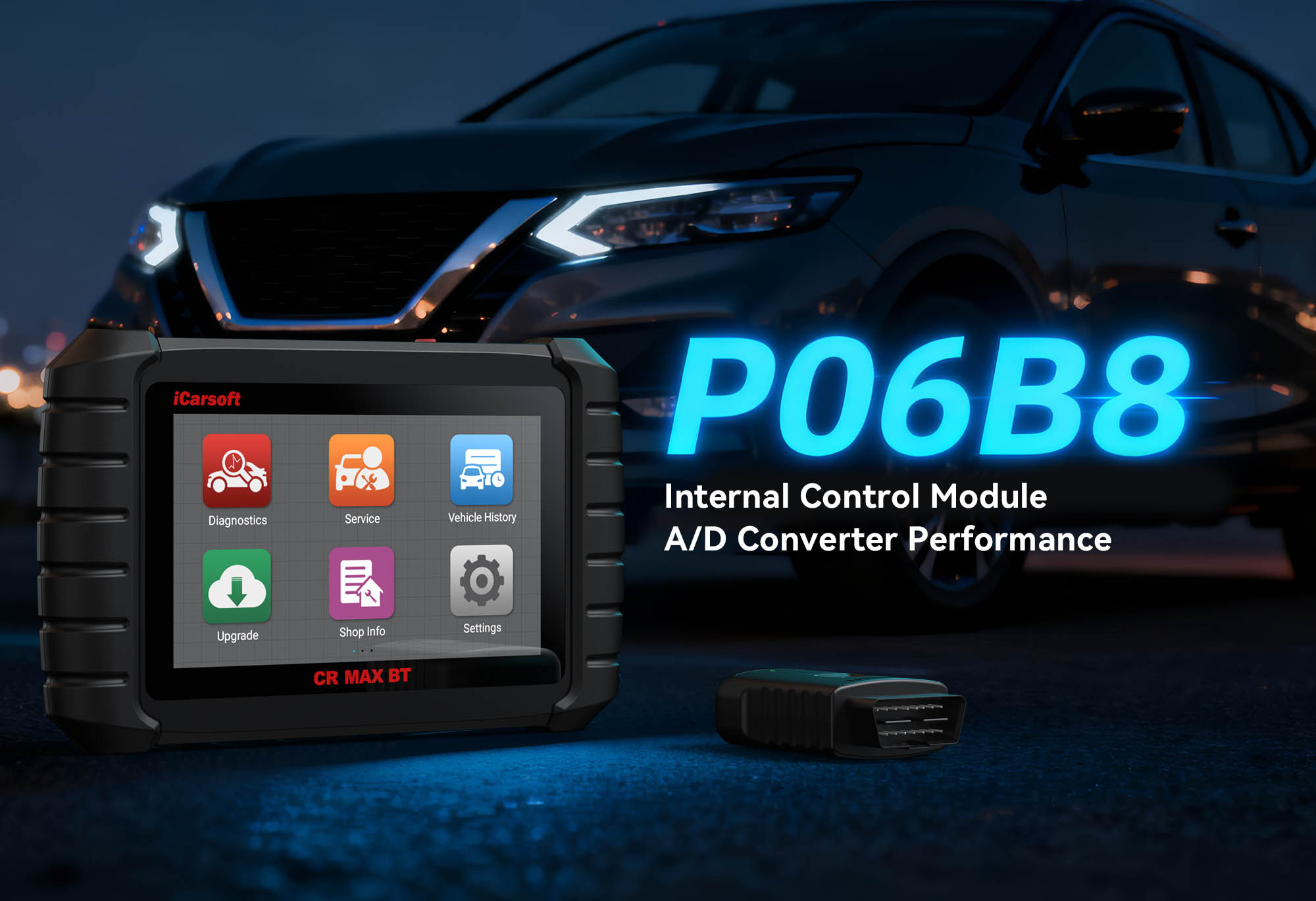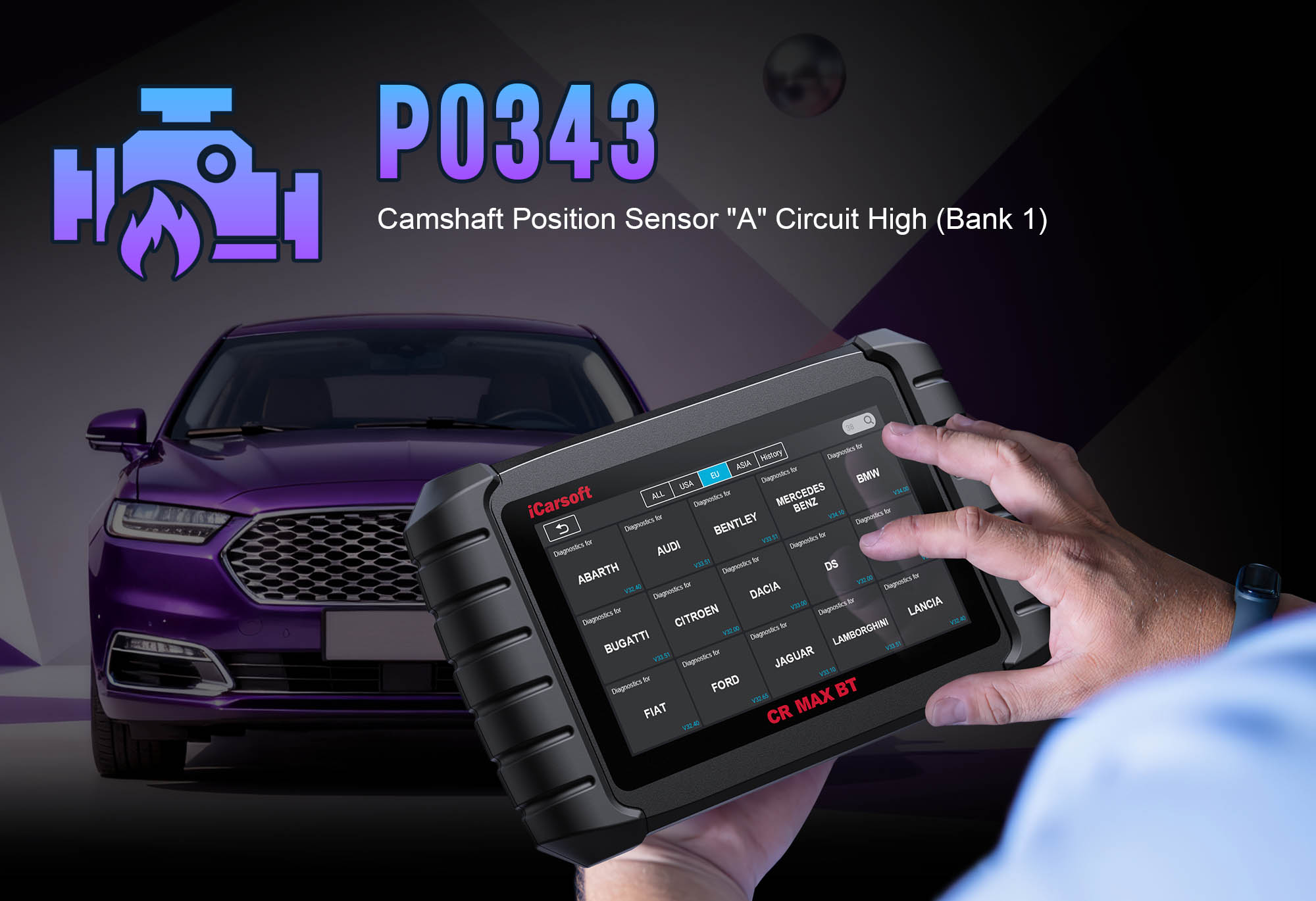P059F Code: How to Diagnose & Fix Thermostat Heater Control Circuit with iCarsoft CR Ultra
If your check engine light illuminates and you notice slow engine warm-up, reduced fuel efficiency in cold weather, or a "Cold Start Delay" warning, a diagnostic scan will likely return P059F. This OBD-II code stands for "Thermostat Heater Control Circuit Performance," indicating the Engine Control Module (ECM) has detected an issue with the electric heater built into modern thermostats—components designed to speed up engine warm-up and optimize temperature regulation.
Modern engines rely on "active thermostats" with integrated electric heaters to bypass the traditional "wait-for-warm" process. The heater activates during cold starts, quickly opening the thermostat to circulate coolant and bring the engine to operating temperature (195–220°F) faster. This not only improves fuel efficiency (cold engines use 10–15% more fuel) but also reduces emissions (cold engines release higher hydrocarbons). P059F triggers when the ECM sends power to the thermostat heater but doesn’t detect the expected temperature rise or circuit response—signaling a fault in the heater, wiring, or control logic. Left unaddressed, it leads to prolonged cold engine operation, increased wear, and failed emissions tests.
Basic scanners may only flag "thermostat heater fault" but can’t test heater functionality or isolate circuit issues. The iCarsoft CR Ultra, with its bidirectional thermostat control, circuit resistance testing, and coolant temperature tracking, solves this. Let’s explore how to diagnose and resolve P059F with precision.
Understanding P059F: Causes & Key Symptoms
A malfunctioning thermostat heater disrupts engine warm-up and temperature control, with symptoms that worsen in cold conditions—these clues help identify whether the issue is electrical or mechanical.
Key Symptoms of P059F
-
Slow Engine Warm-Up: The engine takes 10+ minutes to reach operating temperature (normal = 5–7 minutes), even in mild weather.
-
Reduced Fuel Efficiency: Cold engines burn more fuel—expect 5–10% lower MPG, especially during short trips.
-
Cold-Start Rough Idle: The engine shakes or stalls briefly after startup, as cold coolant delays optimal combustion.
-
Emissions Test Failures: High hydrocarbon (HC) and carbon monoxide (CO) levels, as the engine can’t reach efficient exhaust treatment temperature.
-
Delayed Cabin Heat: Vehicle heater takes longer to produce warm air, or blows cold initially (tied to slow coolant warm-up).
-
ECM Limp Mode (Rare): Severe cases limit RPM to protect the engine from prolonged cold operation—reducing acceleration power.
Common Causes of P059F
|
Cause
|
Description
|
|
Faulty Thermostat Heater
|
Internal burnout or short circuits in the heater element prevent heat generation—common in thermostats over 100,000 miles.
|
|
Wiring/Connector Issues
|
Corroded terminals, frayed wires, or loose plugs in the heater circuit disrupt power flow to the thermostat.
|
|
Failed Heater Relay/Fuse
|
A blown fuse or faulty relay cuts power to the heater—common in older vehicles with electrical wear.
|
|
Coolant Leaks/Low Level
|
Insufficient coolant reduces heat transfer, making the ECM think the heater is failing (even if it’s functional).
|
|
ECM Software Glitch
|
Outdated firmware miscalculates expected temperature rise, triggering false P059F (common in early-adoption vehicles).
|
|
Stuck-Closed Thermostat
|
Mechanical blockage prevents coolant flow, masking heater performance (ECM detects no temperature change).
|
Why iCarsoft CR Ultra Excels at Diagnosing P059F
The CR Ultra outperforms basic tools with features tailored to active thermostat diagnostics—critical for isolating heater, circuit, or sensor-related causes of P059F:
Bidirectional Thermostat Control
Manually activates the thermostat heater to test if it raises coolant temperature—confirms heater functionality without guesswork.
Circuit Resistance Testing
Measures resistance in the heater circuit to detect shorted wires, corroded connectors, or faulty heating elements.
Coolant Temp Correlation
Cross-references heater activation with real-time temp data (e.g., "Heater on = +10°F in 2 min" = working; no rise = faulty).
3D Cooling System Mapping
Displays high-res diagrams of the active thermostat, heater wiring, relay, and hoses for 200+ brands (e.g., "VW Golf: Thermostat = Engine Block, Near Radiator Inlet").
Relay/Fuse Testing
Verifies if the heater relay sends power and if the fuse is intact—avoids unnecessary thermostat replacement.
ECM Firmware Check
Scans for outdated software that may misinterpret heater performance, with one-tap updates via the CR Ultra.
Step-by-Step: Diagnose P059F with iCarsoft CR Ultra
-
Check Coolant Level & Condition First
1. Turn off the engine and wait 30+ minutes for coolant to cool (prevents burns).
2. Open the coolant reservoir—level should be at "MAX." If low, add 50/50 coolant-water mix (use the CR Ultra’s Coolant Type Guide for compatibility).
3. Inspect coolant for discoloration (brown/black = sludge) or leaks—look for wet spots under the radiator, hoses, or thermostat housing.
-
Connect the CR Ultra & Confirm the Code
1. Plug the CR Ultra into the OBD-II port (use adaptors for older models) and power on the tool.
2. Select your vehicle via Auto VIN Scan (instantly pulls specs) or manual entry.
3. Navigate to Engine > Fault Codes > Read Codes to confirm P059F. Tap Code Details for vehicle-specific insights (e.g., "Ford Focus: Check Heater Element & Relay in Fuse Box #2").
-
Locate Active Thermostat & Heater Circuit
1. Go to Component Location > Engine > Cooling System > Active Thermostat with Heater.
2. Use the 3D diagram to identify:
- Active Thermostat: Typically on the engine block, connected to the radiator inlet hose (has a wiring connector).
- Heater Wiring: Path to the ECM/relay (check for heat damage near exhaust manifolds).
- Heater Relay/Fuse: Position in the main fuse box (CR Ultra labels amperage and location).
-
Analyze Live Coolant Temp & Heater Data
1. Ensure the engine is cold (not started for 4+ hours). Start it and let the CR Ultra record data for 10 minutes.
2. Navigate to Engine > Live Data > Cooling System and monitor:
- Coolant Temperature: Working heater raises temp by 15–20°F in 5 minutes. P059F = <5°F rise or erratic readings.
- Heater Status: Should show "Active" for 3–5 minutes on cold start. "Inactive" = no power.
- Heater Circuit Voltage: Normal = 12V when active; <10V = wiring/relay issue; 0V = blown fuse.
-
Test Thermostat Heater Functionality
1. Bidirectional Heater Activation: - Cold engine: Go to Special Functions > Engine > Cooling System > Thermostat Heater Test.
- Select "Manual Activation" for 5 minutes; monitor temp:
- +10–15°F Rise: Heater works (issue is ECM/CTS).
- No Rise: Heater faulty (replace thermostat) or no power (check wiring/relay).
2. Heater Element Resistance: - Turn off engine, disconnect thermostat connector.
- Use multimeter: Normal = 5–15 ohms (varies by OEM). Infinite = burnout; <1 ohm = short.
-
Inspect Wiring, Relay, & Fuse
1. Fuse & Relay Test: - Locate via CR Ultra’s map. Use Fuse Test Mode (beep = good). For relay: Relay Activation Test (click = working).
2. Wiring & Connector Check: - Follow harness for frayed wires/melted insulation (near exhaust). Wiggle connector—voltage fluctuations = loose pins (clean or replace).
-
Rule Out ECM or CTS Issues
1. CTS Validation: - Go to Special Functions > Sensor Tests > Coolant Temp Sensor (CTS) Calibration.
- Compare CTS reading to external probe. >5°F off = faulty sensor (replace it—incorrect data confuses ECM).
2. ECM Software Update: - System > Update Manager checks for firmware updates—many fix P059F false triggers (e.g., cold-climate miscalculations).
-
Repair & Clear P059F
1. Fix the root cause:
- Faulty Heater: Replace thermostat with OEM part (use Part Lookup).
- Circuit Issues: Splice wires, replace fuse/relay, clean connectors.
- CTS/ECM: Replace sensor or update ECM firmware.
2. Clear the code: Navigate to Engine > Fault Codes > Clear Codes to delete P059F.
-
Validate the Repair
1. Cold-start test: Coolant temp should rise 15–20°F in 5 minutes, heater shows "Active."
2. Test drive in cold weather: Cabin heat works quickly, fuel efficiency improves.
3. Emissions Pre-Test: HC/CO levels should be within legal limits (CR Ultra’s Emissions Test confirms).
Preventing P059F Recurrence
Use the iCarsoft CR Ultra to maintain the active thermostat and heater circuit for long-term reliability:
-
Coolant Maintenance: Set Service Reminder to flush/replace coolant every 30,000–50,000 miles (prevents sludge clogging the thermostat).
-
Heater Circuit Checks: Include wiring/relay in annual electrical scans—test resistance/voltage to catch early issues.
-
Software Updates: Enable Update Alerts for ECM firmware releases that address P059F-related bugs.
-
Cold-Start Monitoring: Run Quick Scan after winter cold snaps to ensure heater activation (prevents prolonged cold engine wear).
Conclusion
P059F’s thermostat heater issue may seem minor, but it impacts fuel efficiency, emissions, and engine longevity—especially in cold climates. The iCarsoft CR Ultra simplifies diagnosis with bidirectional heater tests, circuit checks, and temperature correlation, ensuring you fix the root cause (not just replace parts blindly).
By using the CR Ultra to resolve P059F, you’ll restore fast engine warm-up, improve MPG, and keep your vehicle running efficiently—no more waiting for heat or worrying about failed emissions tests. Precision diagnostics mean precise repairs, protecting your engine from unnecessary wear.
FAQs About P059F Code
Q: Can I drive with P059F?
A: Yes, but prolonged driving with a cold engine increases fuel consumption, emissions, and wear. Address P059F within 2–4 weeks to avoid costly repairs.
Q: How much does it cost to fix P059F?
A: $80–$200 for an OEM active thermostat; $30–$100 for wiring/relay repairs; $50–$150 for a CTS. Professional labor adds $100–$200. The CR Ultra ($200–$300) saves by targeting the root cause.
Q: Will flushing the coolant fix P059F?
A: Only if sludge buildup is blocking the thermostat. Use the CR Ultra to confirm—if heater or wiring is faulty, flushing alone won’t help.
Q: Can a bad radiator cause P059F?
A: Indirectly—a clogged radiator reduces coolant flow, making the heater less effective. However, P059F specifically targets the heater circuit, not the radiator itself.





